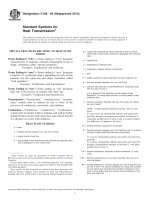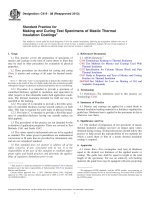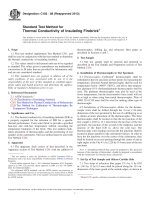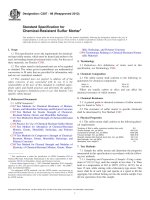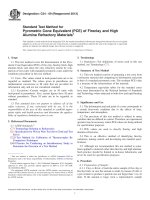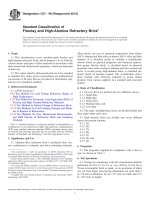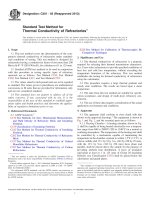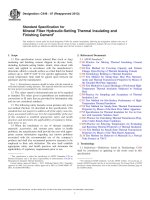Astm c 400 98 (2013)
Bạn đang xem bản rút gọn của tài liệu. Xem và tải ngay bản đầy đủ của tài liệu tại đây (77.58 KB, 3 trang )
Designation: C400 − 98 (Reapproved 2013)
Standard Test Methods for
Quicklime and Hydrated Lime for Neutralization of Waste
Acid1
This standard is issued under the fixed designation C400; the number immediately following the designation indicates the year of
original adoption or, in the case of revision, the year of last revision. A number in parentheses indicates the year of last reapproval. A
superscript epsilon (´) indicates an editorial change since the last revision or reapproval.
1. Scope
3.1.2 pH—a measure of the hydrogen ion concentration of a
sample and representing the logarithm of the reciprocal (negative logarithm) of the activity of hydrogen ions, calculated as
follows:
1.1 This test method covers the testing of quicklime and
hydrated lime for use in the treatment of waste acid solutions
and includes the characterization of the liming material and of
the acid waste.
pH 5 log
1
~H!1
5 2log~ H 1 !
NOTE 1—When agreed upon by the manufacturer and the purchaser,
this method may be used directly to evaluate the lime requirement for a
plant waste acid and in the preparation of the lime slurry; the pH, the time,
temperature, and other conditions of treatment may be adjusted to
conform to plant practice. Otherwise the test shall be performed as
described in this method.
NOTE 2—Under some conditions of test the lime requirement may vary
substantially from that indicated by ultimate chemical analysis or by the
use of a determination of available alkalinity by titration to a stoichiometric end point.
4. Significance and Use
1.2 This standard does not purport to address all of the
safety concerns, if any, associated with its use. It is the
responsibility of the user of this standard to establish appropriate safety and health practices and determine the applicability of regulatory limitations prior to use.
4.2 Liming materials have a specific basicity factor or
measure of alkalinity which can be used for comparing their
relative neutralizing power. It avoids dependence on chemical
analysis and is determined as grams of calcium oxide equivalents per kilogram of liming material.
where:
H+ = activity of hydrogen ions.
4.1 Since all limes and waste acid solutions are different,
this test method evaluates the relative quantity of a given lime
needed for the neutralization of a specific quantity of acid.
4.3 Likewise, specific waste acids have an acid value that
can be expressed as grams of hydrochloric acid equivalent per
litre of acid waste. This value is related on a stoichiometric
basis to lime neutralization requirements of a liquid acid waste.
2. Referenced Documents
2.1 ASTM Standards:2
C50 Practice for Sampling, Sample Preparation, Packaging,
and Marking of Lime and Limestone Products
E70 Test Method for pH of Aqueous Solutions With the
Glass Electrode
5. Apparatus
5.1 pH Measuring Apparatus, conforming to the requirements of Section 5, Apparatus, and Section 6, Reagents and
Materials, of Test Method E70. A time-pH recording device or
attachment is desirable but not required.
3. Terminology
3.1 Definitions:
3.1.1 neutralization coeffıcient—the number of parts of lime
required to neutralize one million parts by weight of sulfuric
acid solution (1.5 %) to a pH of 4.4 in 30 min (see Note 1).
5.2 Analytical Balance, capable of reproducing results
within 0.005 g.
5.3 Stirrer, motorized, capable of rotating at speeds from
120 to 600 r/min.
5.4 Miscellaneous Equipment—Chemically resistant
glassware,3 metal stands for support of the equipment, etc.
1
These test methods are under the jurisdiction of ASTM Committee C07 on
Lime and Limestone and are the direct responsibility of Subcommittee C07.05 on
Chemical Tests.
Current edition approved July 1, 2013. Published August 2013. Originally
approved in 1957. Last previous edition approved in 2006 as C400 – 98 (2006).
DOI: 10.1520/C0400-98R13.
2
For referenced ASTM standards, visit the ASTM website, www.astm.org, or
contact ASTM Customer Service at For Annual Book of ASTM
Standards volume information, refer to the standard’s Document Summary page on
the ASTM website.
6. Purity of Reagents
6.1 Reagent grade chemicals shall be used in all tests.
Unless otherwise indicated, it is intended that all reagents shall
3
Borosilicate glass has been found satisfactory for this purpose.
Copyright © ASTM International, 100 Barr Harbor Drive, PO Box C700, West Conshohocken, PA 19428-2959. United States
1
C400 − 98 (2013)
7.4.2.1 Plot the pH in 30 min, as determined from the
neutralization rate curves described in Section 10, against
grams of lime used per 1000 g of H2SO4 (1.5 %).
7.4.3 Neutralization Coeffıcient:
7.4.3.1 Interpolate the quantity of lime required to achieve a
pH of 4.4 in 30 min from the lime requirement curve (Section
11), correct for the actual acid concentration, and calculate as
parts of lime required per million parts of H2 SO4 (1.5 %) as
follows:
conform to the specifications of the Committee on Analytical
Reagents of the American Chemical Society, where such
specifications are available.4 Other grades may be used, provided it is first ascertained that the reagent is of sufficiently
high purity to permit its use without lessening the accuracy of
the determination.
6.2 Unless otherwise indicated, references to water shall be
understood to mean distilled water.
7. Test Method A—for Determining Lime Requirement for
the neutralization of a standard sulfuric acid or waste acid
solution within a time limit of thirty minutes.
N 5 ~ 1.5/Z ! 3 X 3 1000
where:
N = neutralization coefficient (see 3.1.1),
X = grams of lime per 1000 g of H2SO4 (1.5 %), and
Z = concentration of the H2SO4 to the nearest 0.005 %, as
determined by analysis.
7.1 Reagents:
7.1.1 Sulfuric Acid, Standard Solution (1.5 6 0.05 %)—
Thoroughly mix 15.8 g of concentrated sulfuric acid (95 %
H2SO4 ) with water, dilute to 1 L, analyze to within 0.005 %
H2SO 4, and store in a suitable stoppered bottle.
7.5 Precision and Bias:
7.5.1 The precision and bias of this test method has not been
determined at this time. Replicate samples are recommended.
7.2 Preparation of Sample:
7.2.1 Take samples of quicklime and hydrated lime in
accordance with Methods C50.
7.2.2 Quicklime—Weigh a sample of quicklime (2.50 6
0.01 g) ground to pass a No. 50 mesh sieve. Add to a 500-mL
tall-form beaker containing 50 mL of boiling water and
continue to boil for 2 min. Remove from hot plate and continue
stirring with a magnetic stirrer until the slurry reaches room
temperature (at least 10 min).
7.2.3 Hydrated Lime—Mix a sample of hydrated lime (2.50
6 0.01 g) with 50 mL of water in a 500-mL tall-form beaker
for at least 10 min.
8. Test Method B—For Determining Acid Value-Basicity
Factor Relationship
8.1 Procedure:
8.1.1 Basicity Factor—Weigh 2.804 g 6 1 mg of the sample
that has been prepared to pass a No. 100 (150-µm) sieve and
transfer to a 500-mL Erlenmeyer flask containing approximately 20 mL of cold water. (For quicklime samples, heat to
boiling to ensure complete slaking). Add from a buret 100 mL
of 1.0 N hydrochloric acid and stopper with a two-hole rubber
stopper (Note 3). The quantity of acid may be increased or
decreased depending on the equivalent strength of the material
being tested. Place the flask on a hot plate and boil for 15 min.
(Glass beads may be added to prevent bumping.) Remove the
flask from the hot plate and cool in water. Add several drops of
phenolphthalein indicator solution and titrate the excess acid
with 0.5 N sodium hydroxide solution. Calculate the basicity
factor as follows:
7.3 Procedure:
7.3.1 Place the pH electrodes within the beaker about 1⁄2 in.
(13 mm) above the surface of the lime slurry sample. Set the
motor stirrer to the highest speed at which splattering or
immersion of the electrodes does not occur. Measure 250 g of
H2SO 4 (1.5 6 0.05 %) into a separate 500-mL beaker. Add this
acid to the sample in a single motion and record the pH as a
function of time for a period of 30 min (see Note 1).
7.3.2 Test a second slurry sample using more or less than
250 g of H2SO4 (1.5 6 0.05 %), as indicated by the pH value
observed after 30 min reaction in the first test. Repeat the
procedure at least four times or until sufficient data are
available to give a family of curves that indicate pH at 30 min
as a function of grams of lime per 1000 g of H2 SO4 (1.5 %),
with particular emphasis in the region of pH equals 4.4.
Basicity factor 5 @ ~ V 1 N 1 2 V 2 N 2 ! /W # 3 0.02804
where:
V1 = HCl (mL) required for titration of the sample,
N1 = normality of HCl,
V2 = NaOH solution (mL) required for titration of the excess
acid,
N2 = normality of NaOH solution, and
W = sample (g).
7.4 Results:
7.4.1 Neutralization Rate Curves:
7.4.1.1 Plot pH versus time in minutes for each of the
lime-acid ratios used in the initial series of tests. This family of
curves serves as the basis for calculation of the lime requirements.
7.4.2 Lime Requirement Curve:
NOTE 3—A water-cooled condenser with a tapered, ground-glass joint
and a magnetic stir plate may be used during the boiling step.
8.1.2 Acid Value—Pipet 10 mL of the sample of acidic waste
into a 250-mL Erlenmeyer flask. This quantity may be increased or decreased depending on the strength of the acidic
waste. Add an excess of 25 to 30 mL of 0.5 N sodium
hydroxide solution and boil for 3 min. Filter through a small
Büchner funnel with the aid of vacuum. Wash the residue on
the funnel with water. Add several drops of phenolphthalein
indicator solution to the filtrate and titrate the excess sodium
4
“Reagent Chemicals, American Chemical Society Specifications,” Am. Chemical Soc., Washington, DC. For suggestions on the testing of reagents not listed by
the American Chemical Society, see “Reagent Chemicals and Standards,” by Joseph
Rosin, D. Van Nostrand Co., Inc., New York, NY, and the “United States
Pharmacopeia.”
2
C400 − 98 (2013)
hydroxide with 1.0 N hydrochloric acid solution. Calculate acid
value as follows:
Acid value
3 0.7691
Basicity factor
5 lime or limestone product ~ kg! per litre of Acidic Waste.
NOTE 4—When agreed upon between the manufacturer and the
purchaser, Test Method A may also be used.
Acid value 5 @ ~ V 1 N 1 2 V 2 N 2 ! /V # 3 0.03646
where:
V1 = NaOH solution (mL) required for titration of the
sample,
N1 = normality of NaOH solution,
V2 = HCl (mL) required for titration of the excess NaOH
solution,
N2 = normality of HCl, and
V
= sample (mL).
8.2 Precision and Bias:
8.2.1 The precision and bias of this test method has not been
determined at this time. Replicate samples are recommended.
9. Keywords
9.1 acid value; alkalinity; basicity; lime requirement; liming
material; neutralization; neutralization coefficient; pH; waste
acid
8.1.3 Relationship of Acid Value to Basicity Factor—
Calculate the acid value-basicity factor relationship as follows:
ASTM International takes no position respecting the validity of any patent rights asserted in connection with any item mentioned
in this standard. Users of this standard are expressly advised that determination of the validity of any such patent rights, and the risk
of infringement of such rights, are entirely their own responsibility.
This standard is subject to revision at any time by the responsible technical committee and must be reviewed every five years and
if not revised, either reapproved or withdrawn. Your comments are invited either for revision of this standard or for additional standards
and should be addressed to ASTM International Headquarters. Your comments will receive careful consideration at a meeting of the
responsible technical committee, which you may attend. If you feel that your comments have not received a fair hearing you should
make your views known to the ASTM Committee on Standards, at the address shown below.
This standard is copyrighted by ASTM International, 100 Barr Harbor Drive, PO Box C700, West Conshohocken, PA 19428-2959,
United States. Individual reprints (single or multiple copies) of this standard may be obtained by contacting ASTM at the above
address or at 610-832-9585 (phone), 610-832-9555 (fax), or (e-mail); or through the ASTM website
(www.astm.org). Permission rights to photocopy the standard may also be secured from the Copyright Clearance Center, 222
Rosewood Drive, Danvers, MA 01923, Tel: (978) 646-2600; />
3

